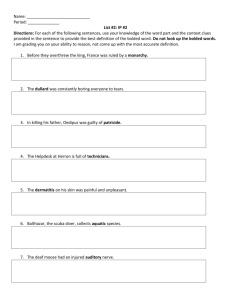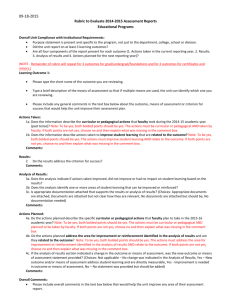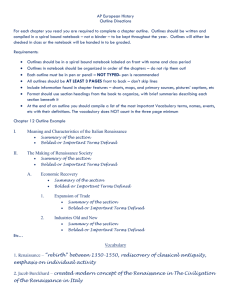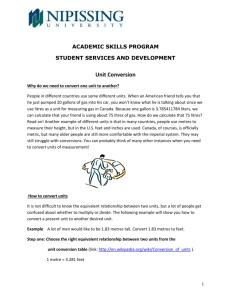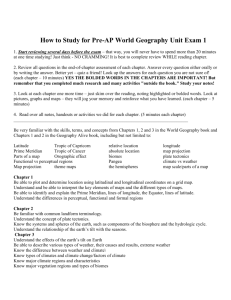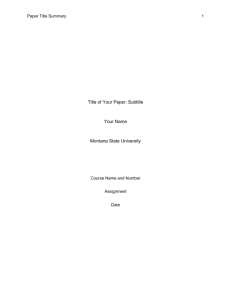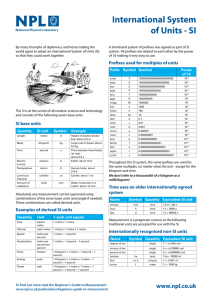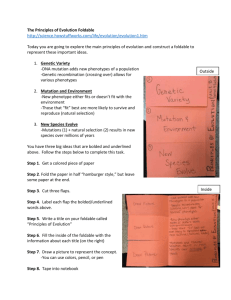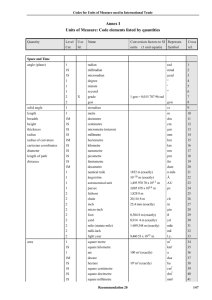PLACE VALUE: METRIC SYSTEM - Society for Quality...PLACE
advertisement
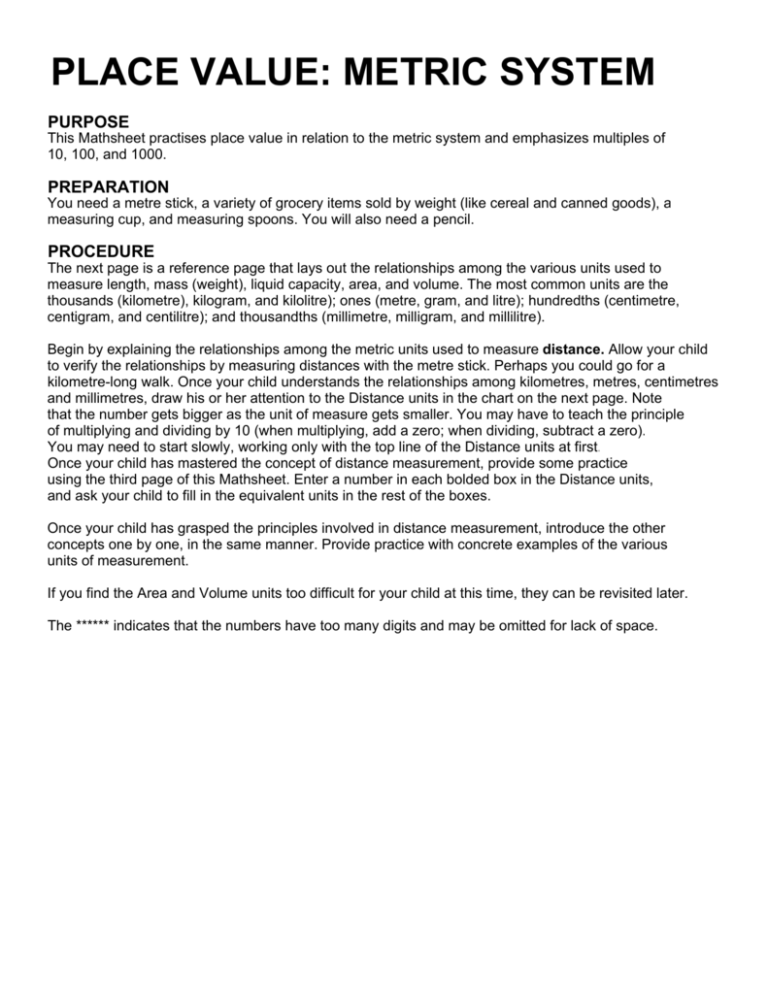
PLACE VALUE: METRIC SYSTEM PURPOSE This Mathsheet practises place value in relation to the metric system and emphasizes multiples of 10, 100, and 1000. PREPARATION You need a metre stick, a variety of grocery items sold by weight (like cereal and canned goods), a measuring cup, and measuring spoons. You will also need a pencil. PROCEDURE The next page is a reference page that lays out the relationships among the various units used to measure length, mass (weight), liquid capacity, area, and volume. The most common units are the thousands (kilometre), kilogram, and kilolitre); ones (metre, gram, and litre); hundredths (centimetre, centigram, and centilitre); and thousandths (millimetre, milligram, and millilitre). Begin by explaining the relationships among the metric units used to measure distance. Allow your child to verify the relationships by measuring distances with the metre stick. Perhaps you could go for a kilometre-long walk. Once your child understands the relationships among kilometres, metres, centimetres and millimetres, draw his or her attention to the Distance units in the chart on the next page. Note that the number gets bigger as the unit of measure gets smaller. You may have to teach the principle of multiplying and dividing by 10 (when multiplying, add a zero; when dividing, subtract a zero). You may need to start slowly, working only with the top line of the Distance units at first. Once your child has mastered the concept of distance measurement, provide some practice using the third page of this Mathsheet. Enter a number in each bolded box in the Distance units, and ask your child to fill in the equivalent units in the rest of the boxes. Once your child has grasped the principles involved in distance measurement, introduce the other concepts one by one, in the same manner. Provide practice with concrete examples of the various units of measurement. If you find the Area and Volume units too difficult for your child at this time, they can be revisited later. The ****** indicates that the numbers have too many digits and may be omitted for lack of space. METRIC PLACE VALUE RELATIONSHIPS NOTE: King Henry Doesn't Mind Drinking Cold Milk is a mneumonic device you may find helpful. Prefix Meaning Distance Mass Liquid KING kilo1000 km kg kL HENRY hecto100 hm hg hL DOESN'T deca10 dam dag daL MIND metre 1 m g L DRINKING deci1/10 dm dg dL COLD centi1/100 cm cg cL MILK milli1/1000 mm mg mL DISTANCE IN RELATION TO THREE STARTING UNITS (1m, 1mm, 1km) Starting unit km hm dam m (metre) dm cm mm 1m 0.001 0.01 0.1 10 100 1000 1 1 mm 0.000001 0.00001 0.0001 0.001 0.01 0.1 1 1 km 10 100 1000 10000 100000 1000000 1 MASS (WEIGHT) IN RELATION TO THREE STARTING UNITS (1g, 1mg, 1kg) Starting unit kg hg dag g (gram) dg cg mg 1g 0.001 0.01 0.1 10 100 1000 1 1 mg 0.000001 0.00001 0.0001 0.001 0.01 0.1 1 1 kg 10 100 1000 10000 100000 1000000 1 LIQUID CAPACITY IN RELATION TO THREE STARTING UNITS (1L, 1mL, 1kL) Starting unit kmL hL daL L (litre) dL cL mL 1L 0.001 0.01 0.1 10 100 1000 1 1 mL 0.000001 0.00001 0.0001 0.001 0.01 0.1 1 1 kL 10 100 1000 10000 100000 1000000 1 RULE 1 for Distance, Mass, Liquid Capacity: When moving to the next smaller unit multiply by 10. RULE 2 for Distance, Mass, Liquid Capacity: When moving to the next larger unit divide by 10. AREA IN RELATION TO THREE STARTING UNITS (1m2, 1mm2, 1km2) Starting unit 1 m2 1 mm2 km2 0.000001 hm2 0.0001 dam2 0.01 m2 1 dm2 100 c2 10000 mm2 10000000 ****** ****** ****** 0.000001 0.0001 0.01 1 2 100 10000 1000000 ****** ****** 1 km 1 RULE 1 for Area (2 dimensions): When moving to the next smaller unit multiply by 100. RULE 2 for Area (2 dimentions): When moving to the next larger unit divide by 100. VOLUME IN RELATION TO THREE STARTING UNITS (1m3, 1mm3, 1km3) hm3 dam3 m3 dm3 km3 Starting unit 1 m3 3 1 mm 3 ****** cm3 mm3 0.000000001 0.000001 0.001 1 1000 1000000 1000000000 ****** ****** ****** 0.000000001 0.000001 0.001 1 1000 1000000 1000000000 ****** ****** 1 km 1 RULE 1 for Volume (3 dimensions): When moving to the next smaller unit multiply by 1000. RULE 2 for Volume (3 dimensions): When moving to the next larger unit divide by 1000. ****** Write a different number in each bolded box and have your child fill in the other units. Question km hm dam m (metre) dm cm 1 2 3 4 5 6 7 Write a different number in each bolded box and have your child fill in the other units. Question kg hg dag g (gram) dg cg 8 9 10 11 12 13 14 Write a different number in each bolded box and have your child fill in the other units. Question kmL hL daL L (litre) dL cL 15 16 17 18 19 20 21 Write a different number in each bolded box and have your child fill in the other units. Question hm2 dam2 m2 dm2 c2 km2 22 23 24 25 26 27 28 Write a different number in each bolded box and have your child fill in the other units. Question hm3 dam3 m3 dm3 cm3 km3 29 30 31 32 33 34 35 Water at 4 degrees Celsius: 1 g occupies 1 mL or 1 cm3, 1 kg occupies 1 L or 1 dm3, 1 tonne occupies 1 kL or 1 m3. Designed by David Harris (1992) mm mg mL mm2 mm3
